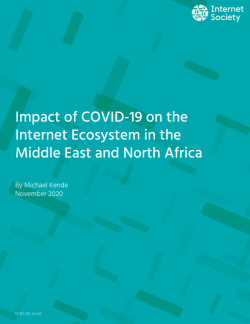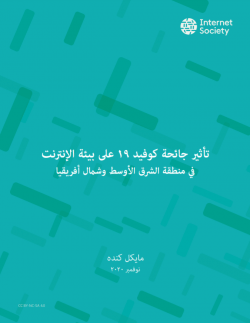Author: Michael Kende
The author would like to thank Jane Coffin, Nermine El Saadany, Hana Sabbagh, David Belson, Michuki Mwangi, and Naveed Haq for their leadership and input into this report. The Internet Society, along with the author, would like to thank Internet Society chapter members for their replies to a questionnaire and participants in a June 29, 2020 webinar for their questions and feedback.
Executive Summary
The Coronavirus (COVID-19) pandemic has increased reliance on the Internet, in light of widespread lockdowns and requirements to socially distance. It has allowed family and friends to keep in touch, businesses and governments to continue functioning, students to learn, and patients to access healthcare services. This surge in reliance on the Internet highlights the need to both increase Internet infrastructure and close the digital divide.
Internet infrastructure encompasses access (including international and national fiber networks to deliver traffic between and within countries), interconnection between networks at Internet Exchange Points (IXPs), and content and services hosting at data centers. While the Internet has proven to be resilient to the increased demand, governments can still make improvements to address the needs of the crisis, as well as the longer-run requirements to bridge the digital divide and transform to a digital economy.
In the short run, during the crisis, it has generally not been possible to build or update infrastructure, given the time needed, the restrictions on travel, and the need for social distancing. Instead, to accommodate increased demand, regulators in a number of countries have made more spectrum available to operators to provide more bandwidth, and a number of streaming services have reduced the definition of their video to decrease the traffic generated. To make the increased usage more affordable, operators have increased their data caps, and are sometimes not counting access to educational and healthcare services against these caps, often in coordination with the regulator.
In the medium run, when the lockdown and need for social distancing have ended, but before new infrastructure can be built, governments can take additional actions to meet demands for increased Internet infrastructure. These include boosting competition for international and national capacity, providing more spectrum to mobile operators and other providers, and developing regulations to promote more local content hosting. To maximize local traffic exchange, any restrictions on access to a local IXP should be removed. The use of digital payments should also be introduced or increased, in order to promote the digital economy.
Finally, in the long run, when it is possible to build more infrastructure, a national broadband plan should be adopted or updated. The regulator can increase the number of licenses for access infrastructure and help to facilitate building international and national fiber. It can focus on deploying more fixed and mobile broadband, using new technologies where feasible, and new models such as community networks. The plan can also help to expand existing IXPs or support the development of new ones. In addition, government policy should aim to increase digital literacy and help to promote the creation of new content and services.
The COVID-19 crisis has highlighted how much we rely on the Internet for our work, access to government services, communication, and education. Governments should build on their responses to the crisis with longer-term planning for the Internet to become universal and affordable in their countries.
Introduction
The COVID-19 pandemic has been a profound global shock. It has required people to stay at home, if possible, and socially distance themselves from others when outside the home. Businesses, industries, schools and governments closed in many countries, limiting the ability to earn a living, gain an education, and provide important government services. The Internet has bridged the distance in many cases, allowing family and friends to communicate and entertain themselves, enabling people to work at home, helping students do virtual learning, and providing online tools, including health advice, to help fight the pandemic. On the other hand, the impact has not been universal, highlighting the need for policy and regulatory solutions to bridge digital divides.
The response to the pandemic has provided a general validation of the Internet’s design, albeit under such unfortunate and unwanted circumstances.[1] The Internet has largely accommodated the increased usage and has proven resilient. However, the increased demand for access and usage has highlighted existing gaps in access and infrastructure, in terms of both the Internet access networks’ reach and capacity. At the same time, the demands have changed, pointing toward needs for online content and services, for work, school, government services, socializing, shopping, health, and entertainment.
The crisis has magnified the digital divide within and between countries, while also changing the dimensions. It is important not just to consider users who are online and offline, but also those who are just marginally online. These are people who can afford a minimum level of service, but cannot afford the increased usage required to accommodate their increased needs for access. At the same time, it is not just a question of whether countries have a digital economy that can develop content and services to meet new demands—newly developing digital economies may not be able to deliver the content and services quickly enough to address the needs of the lockdown.
A number of governments and companies are responding to the challenges with innovative solutions that will help address the gaps in the markets. Many of the solutions are aimed at the short run, to address the immediate challenges of the unanticipated lockdowns and need for social distancing. At the same time, they cannot fill all the gaps with short-run solutions. Some of them will require planning, which governments and businesses should address soon. In the longer run it is possible that the new-found familiarity with online tools will result in a “new normal” where online work, education, and socializing become more acceptable and common. The changes being made now can help to make that possible.
This paper focuses on the challenges of addressing the COVID-19 crisis and its potential aftermath in the Middle East and North Africa (MENA), and builds on a previous report that provides more general policy recommendations on the same topics, outside the context of the response to the pandemic.[2]
Endnotes
[1] See David Belson, “The Internet Is Resilient Enough to Withstand Coronavirus – But There’s a Catch,” Internet Society, 13 May 2020, https://www.internetsociety.org/blog/2020/05/the-internet-is-resilient-enough-to-withstand-coronavirus-but-theres-a-catch. The catch is that last mile broadband is not widely accessible and affordable. See also https://www.washingtonpost.com/technology/2020/04/06/your-internet-is-working-thank-these-cold-war-era-pioneers-who-designed-it-handle-almost-anything
[2] Michael Kende, “Middle East & North Africa Internet Infrastructure Report,” Internet Society, 18 May 2020, https://www.internetsociety.org/resources/doc/2020/middle-east-north-africa-internet-infrastructure-report

